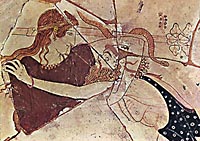

White-ground technique was already well
known in the late Archaic period. Most likely it derived
either from black-figure technique or from imitation of
major painting. On another view, it was connected with
painting on non-standard materials such as ostrich eggs
or ivory. Its connection with lekythoi dates from early on;
but it could also be used on an oinochoe, a kylix, a pyxis, or an alabastron.
Output of kylikes with white-ground decoration on
the outside was mainly confined to the years |
 |
A white-ground lekythos was the standard
grave-offering in Classical times. Why were they there?
Because they contained the oil that was always used in
the burial rite.
There was often a smaller space inside for oil, so that
the user didn't have to fill the whole vessel, thus
economizing on the expenditure of costly oil on the
grave. In the first specimens we have, the drawing was
blocked in outline, just as was done for its model, the
black-figure pot. In the |
Leaving aside scenes from mythology and everyday life, the scenes on lekythoi can be subdivided into two categories: those in which show Death (allegorically, in the form of Charon, Hermes, Thanatos, or Sleep), and those which show human beings directly linked with the rites of burial and with looking after the grave.
Before the mid-5th century the main
painters were the Sabouroff Painter and the Tomb
Painter. They are followed by the Achilles Painter,
whose superb drawings and subjects have only an indirect relation
to the grave. (This is a reason for not excluding the possibility
that some lekythoi were used for purposes other than
burial). Towards the end of the century the
White-ground lekythoi were not nearly so widespread as red-figure pottery. Outside Attica, we find them chiefly in Euboea, Macedonia, and (to a lesser degree) Italy.
 |
 |
|
| |
|||
| |||